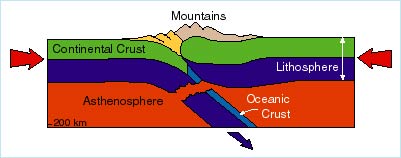 |
 |
 |
 |
 |
 |
 |
 |
| Slag |
 |
 |
 |
Building the Appalachian Mountains
Southwestern Pennsylvania has a long history of sedimentation punctuated by mountain building episodes (orogenies). Until about 250 million years ago, most of the sediment was deposited in a deltaic system feeding into a shallow marine environment. The inland sea was gone by the time that dinosaurs roamed the Earth (Mezazoic Era), as the collision of Europe and Africa with North America created high mountains and pushed southwestern Pennsylvania up well above sea level.
Approximately one billion years ago, the eastern edge of North America
slammed into another continent, resulting in the Grenville Orogeny, an episode of mountain building.
The roots of those mountains experienced intense deformation by heat and
pressure, creating metamorphic rocks. The roots are all that remain of the mountains
formed during the Grenville Orogeny, exposed in some parts of eastern
Pennsylvania.
Approximately 650 million years ago, the joined
continents began to pull apart. An ocean began to form between what is now
North America and Europe. This ocean, known as Iapetus, gradually widened
during the next 200 million years.
The ocean then began to close again.
As the continents crept towards each other, the ocean basin got smaller through
subduction, a process by which relatively dense lithosphere is shoved under
relatively buoyant lithosphere. Subduction can involve oceanic lithosphere
being shoved under continental lithosphere, resulting in mountains, or old, cold
oceanic crust being shoved under young, hot oceanic lithosphere, resulting in a
chain of volcanic islands in the ocean (an island arc). As the downgoing slab
descends, it is heated and begins to melt. The molten rock (magma) rises
towards the surface, fueling volcanoes. Examples of subduction-related
volcanoes include the Cascades in Washington State, Mt. Pinatubo in the
Phillipines, and, perhaps the most famous of all, Mt. Fugi in Japan.

The Taconic Orogeny, the next mountain-building event that affected the Pittsburgh area, occured approximately 445 - 435 million years ago, as North America collided with an island arc (a string of subduction-related volcanic islands, like Japan and the Phillipines, formed when oceanic crust subducts under oceanic crust). When the island arc ran into North America, intense folding, thrust faulting, metamorphism, and volcanism occured. Mountains were raised in eastern Pennsylvania, and central Pennsylvania buckled to form a basin. The rising mountains began to erode and rivers carried the sediment westward into the basin. The basin first received lots of black mud, with some silt and fine sand. As erosion continued to eat away at the Taconic Mountains, huge amounts of sediment were carried into central and western Pennsylvania, and were deposited in a giantdelta. Known as the Catskill delta, the sedimentary rocks formed from this delta are as much as 4000 feet of thick at their thickest point. The delta stretched from New York through central Pennsylvania, thinning to the northwest. Approximately 1500 feet of sediment was deposited in Erie, Pennsylvania.
30 million years
of tectonic quiet
followed the Taconic Orogeny. During this quiet time, North America experienced
simple subduction of oceanic crust as the proto-Atlantic ocean continued to
shrink.
During the Middle and Late Devonian (approximately 375 - 355
million years ago), the final closure of the proto-Atlantic Ocean began with the
collision of North America and Europe. This collision event is called the
Acadian Orogeny. Another range of mountains formed east of Pennsylvania, east
of the by then deeply eroded Taconic Mountains. Pennsylvania received even more
sediment from the erosion of these mountains than from the Taconian Mountains,
forming an even larger delta.

The Alleghenian Orogeny occurred during the Pennsylvanian and Permin Periods, approximately 300 - 220 million years ago. This orogeny resulted from collision between North America and Africa, completing the closure of the proto-Atlantic Ocean. The sediment eroded from these new mountains formed the sedimentary rocks that are now exposed at the surface throughout most of western Pennsylvania.
LINKS:
U.S. Geological Survey